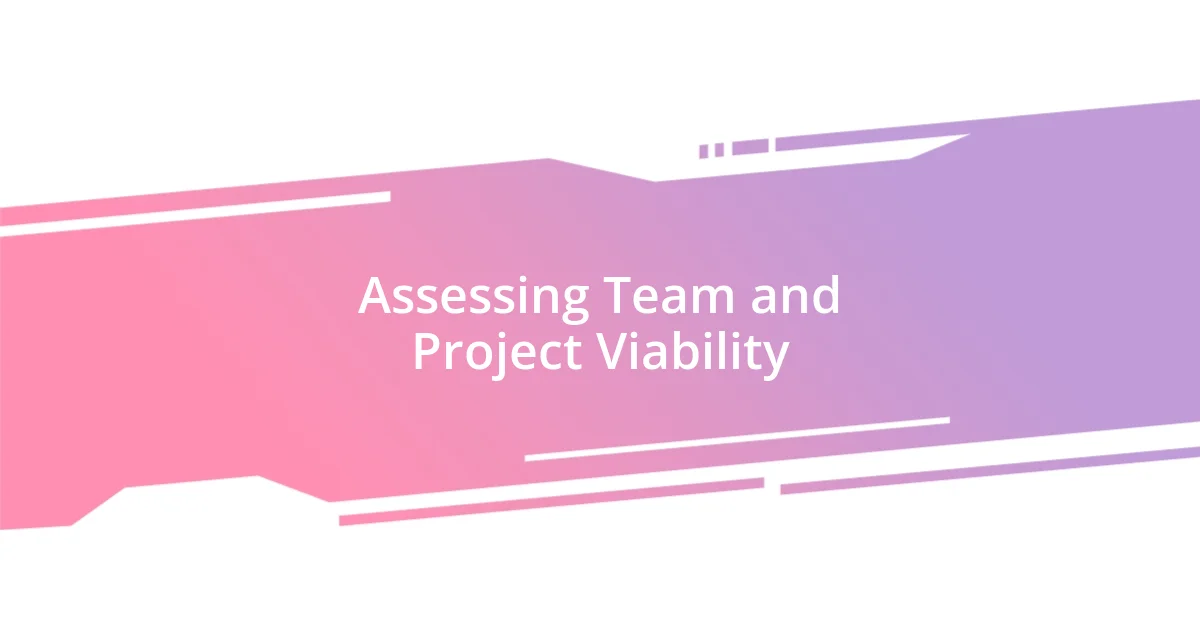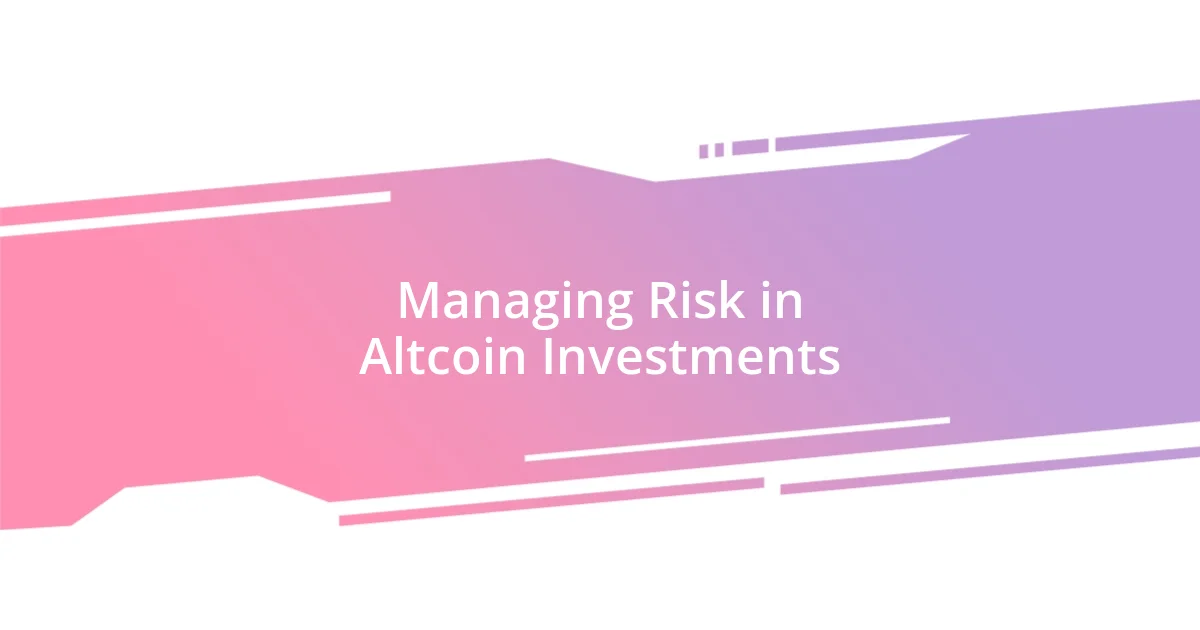Key takeaways:
- Understanding the unique functions and technologies of various altcoins is essential for informed investment decisions.
- Key factors for identifying promising altcoins include evaluating technology, team experience, community engagement, market potential, and partnerships.
- Effective risk management through diversification, stop-loss orders, and continuous market monitoring is crucial for safeguarding investments in the volatile altcoin market.

Understanding Altcoin Basics
When I first delved into altcoins, I was struck by the sheer variety available. Altcoins are essentially any cryptocurrencies that aren’t Bitcoin, encompassing a wide range of projects with different purposes and technologies. This diversity can feel overwhelming—how do you even begin to sift through them all?
Each altcoin typically serves a unique function within its respective ecosystem. Some focus on privacy, like Monero, while others aim to improve transaction speeds, like Ripple. Reflecting on my early days, I remember getting burned by investing in a coin solely based on hype without understanding its fundamentals. Have you experienced that rush of excitement, only to realize later that the underlying project lacked viability?
Understanding the technology behind altcoins isn’t just beneficial; it’s essential if you want to make informed decisions. For instance, learning about smart contracts during my own research gave me a new perspective on projects like Ethereum. I couldn’t help but wonder: what potential innovations might arise from the altcoin space in the future, and how could they shape our financial landscape?

Identifying Promising Altcoins
Identifying promising altcoins requires a keen eye for detail and a willingness to dig deeper. It’s easy to get lured in by flashy marketing and social media buzz, but I’ve learned that the real potential often lies beneath the surface. I remember a time when I invested in an altcoin that had a vibrant community but lacked a solid roadmap. It felt like I was riding a rollercoaster, full of ups and downs, but eventually, the lack of direction led to a disappointing exit.
To help guide your analysis, consider these factors when identifying promising altcoins:
- Technology: Evaluate the underlying technology and its actual use case. Is it just a copycat, or does it bring something new to the table?
- Team: Research the team behind the project. Do they have relevant experience and a transparent track record?
- Community Engagement: A passionate and active community often indicates strong support, which can drive long-term growth.
- Market Potential: Look for niches that have room for growth. Does the coin solve a real problem that hasn’t been addressed yet?
- Partnerships: Solid collaborations with established companies can enhance credibility and offer practical use cases for the altcoin.
Each of these factors has guided my decision-making process. I vividly recall the excitement I felt when I discovered an emerging altcoin that ticked all these boxes, turning out to be a worthwhile investment. That experience reaffirmed my belief that thorough research pays off.

Evaluating Market Trends
Evaluating market trends is paramount when analyzing altcoins. I’ve found that keeping an eye on overall market movements can help me identify the right entry and exit points. For example, during periods of bullish momentum, certain altcoins tend to gain traction, and I can remember instances when I jumped in just as they began to surge. It’s thrilling, yet it also requires a balanced approach, as market climates shift rapidly.
Tracking trading volumes is another essential aspect of evaluating trends. Increased volume often signals heightened interest and can indicate potential price movements. I once watched an altcoin’s volume triple on a single day, which prompted me to research what was driving that interest. It turned out to be an upcoming partnership announcement that led to a significant price jump shortly after. Recognizing these patterns has been invaluable in my own strategies.
In addition to volume, observing price actions and chart patterns can provide insights into market sentiments. Patterns like head and shoulders or flags can indicate potential reversals or continuations. I still recall the rush of analyzing a coin that formed a bullish flag pattern, resulting in a sizeable profit when it eventually broke out. It’s those moments that remind me of the importance of not just following the news, but also trying to understand what’s happening behind the scenes.
| Market Indicator | Significance |
|---|---|
| Trading Volume | Indicates interest and potential price movement |
| Price Action | Reflects market sentiment and can highlight trends |

Analyzing Technical Indicators
Analyzing technical indicators is a crucial part of my altcoin strategy. Personally, I often rely on tools like moving averages to smooth out price data and identify trends. I remember when I first learned how the 50-day moving average can signal bullish or bearish trends; it was like unlocking a door to another level of understanding. Have you ever noticed how a simple line can change your perspective on a coin’s potential?
Another key indicator I pay attention to is the Relative Strength Index (RSI). This tool helps me gauge whether an altcoin is overbought or oversold. I had an instance when the RSI for a promising coin hit an extreme level; rather than jumping in, I waited. This patience paid off when the price corrected itself, providing me a better entry point. It was a valuable lesson in not letting excitement cloud my judgment.
I also analyze candlestick patterns, which can be incredibly revealing. I’ve seen how a single bullish engulfing candle can signify a reversal, often igniting a surge of buying pressure. The thrill of spotting these patterns is exhilarating, as it makes me feel tuned into the market’s pulse. Do you find yourself captivated by these signals too? Recognizing what these patterns tell us about market psychology can be an edge in the chaotic world of altcoins.

Assessing Team and Project Viability
When I assess the team behind an altcoin, I consider their experience and track record in the cryptocurrency space. I remember coming across a project led by developers with a strong background in blockchain technology, and it instantly gave me more confidence. Have you ever realized how a team’s past successes or failures can directly influence your perception of their current venture?
It’s also crucial to dive into the project’s roadmap and milestones. Recently, I examined an altcoin that presented a detailed timeline of developments and partnerships. Seeing that clarity in their goals not only impressed me but also made me more inclined to invest. It’s like peeking into the future—if they have a well-defined plan, there’s a better chance they’ll execute successfully.
Moreover, connecting with the community around a project is something I prioritize. I often browse forums and social media to gauge how engaged and passionate the supporters are. There was an altcoin where I noticed a vibrant community rallying around it, which sparked my interest. I find that an active and dedicated user base can be a strong indicator of a project’s longevity and overall health. Isn’t it fascinating how community sentiment can sometimes sway the momentum of a project?

Managing Risk in Altcoin Investments
When it comes to managing risk in altcoin investments, diversification is key for me. I typically avoid putting all my eggs in one basket. For example, in my early days, I invested heavily in a single coin, and when it faltered, my portfolio suffered tremendously. This experience taught me the importance of spreading out my investments across different projects to cushion against potential losses—have you ever felt the sting of putting too much faith in one asset?
Another strategy I implement is setting clear stop-loss orders. This tactic acts like a safety net, allowing me to limit losses in volatile markets. I remember a particular altcoin that spiked dramatically, only to crash just as fast. Having a stop-loss in place saved my investment from tumbling down without warning. It’s astonishing how a little planning can make such a big difference in safeguarding your capital—do you have a plan for when things don’t go as expected?
Lastly, I find that continuous learning and monitoring the market rhythm play vital roles in risk management. Staying informed about regulatory changes, technological advancements, and market sentiment helps me adapt my strategies. I vividly recall a time when a sudden news article shifted market perceptions overnight; my awareness of the news cycle equipped me to react promptly. How do you stay ahead of the curve? Embracing an adaptable mindset can empower us to manage risk effectively and seize opportunities in the ever-changing altcoin landscape.

Creating a Diversified Portfolio
Creating a diversified portfolio means exploring various altcoins rather than sticking to one or two. I learned this the hard way after investing solely in a project I believed in deeply; it eventually plummeted, and I realized the risk I was taking. Have you ever faced a similar situation? Spreading investments across multiple coins provides a safety net, safeguarding against market volatility.
Another approach I find effective is categorizing my altcoin investments. I often divide them into different sectors, such as DeFi, NFTs, and layer-1 solutions. One time, I focused heavily on a rising NFT project; while it provided significant returns, my other investments in stable DeFi projects balanced my overall portfolio. It’s a bit like having a balanced diet—each coin plays its role in maintaining my portfolio’s health.
Furthermore, I regularly reassess my allocations based on performance and market changes. I recall a moment when a promising altcoin started underperforming, and I made the decision to shift some funds into a more vibrant project. How do you decide when to cut losses or let a coin ride its course? Keeping a flexible mindset allows me to navigate the ever-changing crypto landscape and make informed decisions—it’s that adaptability which often leads to success.














